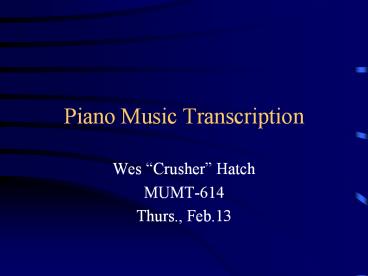Piano Music Transcription - PowerPoint PPT Presentation
Title:
Piano Music Transcription
Description:
Can make assumptions about strengths of various partials (Martin) ... Blackboard systems (Bello, Monti & Sandler, Martin) Neural networks ... – PowerPoint PPT presentation
Number of Views:189
Avg rating:3.0/5.0
Title: Piano Music Transcription
1
Piano Music Transcription
- Wes Crusher Hatch
- MUMT-614
- Thurs., Feb.13
2
Introduction
- Polyphonic pitch extraction
- Want to realize computational scene analysis
(Klaburi) - Problem is comparable to speech recognition
3
Current State of affairs
- Many different approaches
- Nothing is 100 reliable, or even 90or 80
- Drawback no one heuristic means that no one is
building on, or learning from, previous work and
experience
4
Parameters to extract
- Pitch
- Amplitude
- Onset and duration
- Do NOT require
- Spatial location
- timbre
5
Benefits of knowing timbre
- Can assume a piano sound for input, and
- Simplifies things down the road
- Dont need to calculate a sound source model of
an instrument (Marolt) - Can make assumptions about strengths of various
partials (Martin) - Makes other techniques possible (eg. differential
spectrum analysis, Hawley)
6
Recent developments
- A few techniques are gaining prominence
- Blackboard systems (Bello, Monti Sandler,
Martin) - Neural networks
- Pitch perception models based on human audition
(gammatone filterbank front-end) - To a lesser extent
- Hidden Markov models
7
Benefits of Blackboards
- Can incorporate all previous approaches, and
methodologies - Top-down or bottom-up
- Easily expandable
- Can be easily updated to accommodate new
technology
8
A very general heuristic
- Front-end
- Analysis, representation, pitch hypothesis
- Top-down processes, (which in turn effects
front-end analysis and pitch guesses) - Transcribed notes out (Guido, MIDI, etc.)
9
Commonalities between systems
- transform data into freq. representation
- STFT tracking phase vocoder (Dixon)
- Sinusoid tracks (Martin)
- Gammatone filterbank (Marolt, Martin)
- Top-down organization
- System has the ability to learn
- Neural nets (Marolt, Bello)
- HMM (Raphael)
- timbre adaption (Dixon--soon)
10
Top-down is super
- Bottom-up analysis --gt note hypothesis
- Unidirectional
- Doesnt know about past analysis, only concern
is hierarchal flow of data - inflexible
- Top-down high --gt low level
- Different levels of the system are determined by
predictive models and previous knowledge - Implemented by neural nets, blackboard system
11
Happy schematic
- Low level --gt mid-level --gt high level
12
Front-end techniques
- Sinusoidal
- STFT
- Constant frequency spacing means better
resolution in high freq.s, poorer resolution in
low freq. range - tracking phase vocoder
- Sinusoid track
- Track continuous regions of local energy maxima
in time-frequency domain (eg. Dixon)
13
Front-end techniques, cont.
- Correllation
- Try to model human audition
- Constant Q mimics log. resolution of human ear
- Gammatone filterbank
- output of each filter then processed by a model
of inner hair cell dynamics - Further analysis by short-time auto-correllation
- Variable filter widths filters generally
implemented across 70 - 6000 Hz - Same problems as found in scene analysis
14
Onset detection
- Neural nets
- Differences between 6 ms and 18 ms amplitude
envelopes (Martolt) - Change in high frequency content (Bello)
- Zero-lag correlation for each filterbank channel
- Running estimate of energy (Martin)
15
Analysis pitch hypothesis
- Blackboards
- contain a variety of KS
- Neural nets
- fuzzy logic
- May contain front-end processing, or may be fed
results thereof - Can be used for entire process (front-end, data
representation, pitch hypothesis) or just to
tabulate pitch guesses at the end
16
Analysis pitch hypothesis
- Peak-picking together w/phase spectrum (helps to
resolve low freq. uncertainties) - atoms of energy localized in time and frequency
(Dixon) - HMM
- Neural nets (note, chord recognizers)
- trained to look for one given note (eg. C4)
- Can also be a KS in blackboard system
17
Pitfalls
- Octave errors most common error source
- Some solutions
- feedback to provide inhibition from the output
of the note recognition stage to its input
(Martolt) - Instrumental models (have knowledge about
strengths of various partials--spectral shape) - Apply general musical knowledge (voice leading
rules, harmony counterpoint, etc.) (Kashino)
18
Different systems results
- Dixon 70-80 correct
- SONIC (Martolt) 80-95 correct, (13-25
extra notes) - Monti Sandler 74 correct
- Raphael 39 wrong/missed
- Bello, Martin no data available
19
Conclusions
- Exponentially more difficult than monophonic
transcriptions - Are slowly approaching very good, robust systems
- Compare to Moore, 1975
- Very few restrictions in the input data
- Top-level organizations are key
- Blackboards, neural networks































